Millonarios have had an impressive campaign in the Apertura portion of the Categoría Primera A 2022 season. The side from Colombia’s capital finished top of the 20-game Colombian league, which has two league seasons per year, before heading into the first phase of the playoffs.
For the group stage of the playoffs, the Bogotano’s were drawn against Junior F.C, Atlético Bucaramanga and, their major rivals, Atlético Nacional from Colombia’s second city, Medellín. The clásicos between two of the country’s biggest football clubs is the Colombian version of La Liga’s Barcelona versus Real Madrid.
Millos’ hopes of a 16th championship ended Wednesday night when their slim chances of making the final ended with a 2-1 loss to Bucaramanga. This was a disappointing result in an otherwise impressive season. The side, managed by Alberto Gamero, played effective, attacking football with dynamic movements and rotations that have been a joy to watch.
This analysis will be presented in the form of a scout report. The focus will be on how Millonarios build up through central areas and how they utilise their inverted full-backs. In this tactical analysis, we analyse the key tactics behind Millonario’s success in the 2022 campaign.
Statistical analysis
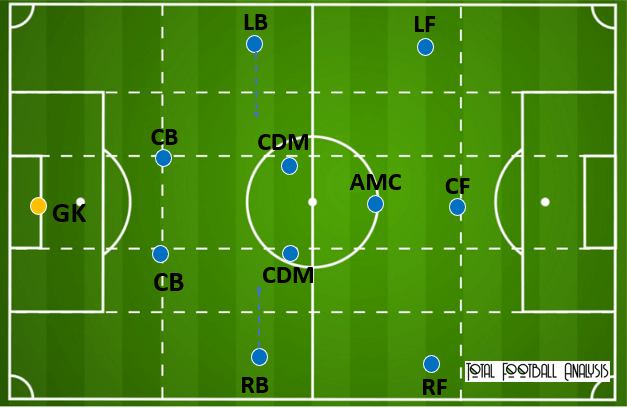
As the above tactical diagram shows, Millonarios set up this season in a 4-2-3-1. This was Gamero’s favoured formation throughout the season, playing it in almost every match.
Although they finished top of the league, they only placed eighth over the whole season for goals scored with 28 in their 26 games. Millos’ top scorer, number ‘7’ Diego Herazo, who is on loan from Independiente Medellín for the 2022 season, scored just six goals. This places Herazo joint tenth for goals scored in the league. There was no Millonarios player in the top 25 for goals and assists. This is despite playing six more games than 12 of the 20 teams.
Millonarios’s struggle for goals comes despite them having the second-highest xG, 33.87, in the league. Their xG suggests they underperformed their expected goal tally by 6 goals over the course of the season. The statistics would suggest the problem, if they have one, is taking the chances they create rather than a lack of goalscoring opportunities being created.
Gamero’s possession-based style is backed up by his team having by far the highest average ball possession, 57.1%, in the league. They also averaged the highest number of passes per 90 minutes with 438.93. This is more than 110 passes above the league average per 90 minutes.
Keeping the ball well contributed to their superb defensive record. Millos averaged the fewest shots against per match and conceded the second-fewest goals.
Build-up play through central areas
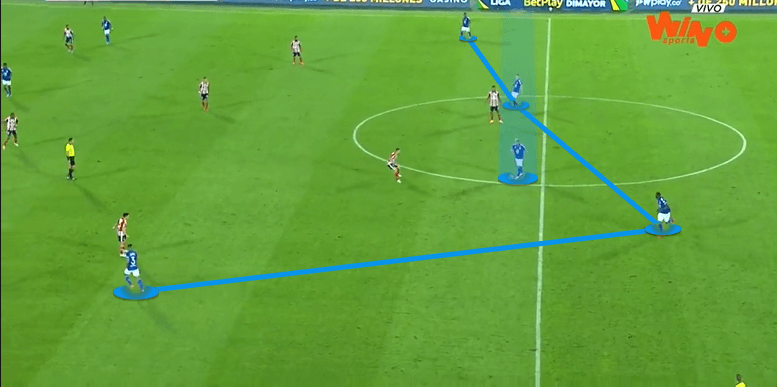
During the build-up phase, Millonarios’s two defensive midfield players often play very far apart. One will drop in-between the centre backs, who split wider creating a back three, and one will be positioned beyond the opposition’s midfield line. As will be covered in the next section, and can be seen in the image above, this leaves the half-spaces for their full-backs to move into.
The above image shows one of the defensive midfielders, number ‘5’ Larry Vásquez, having just picked up the ball between his centre-backs. His defensive midfield partner, out of shot, is playing almost on the opposition’s defensive line.
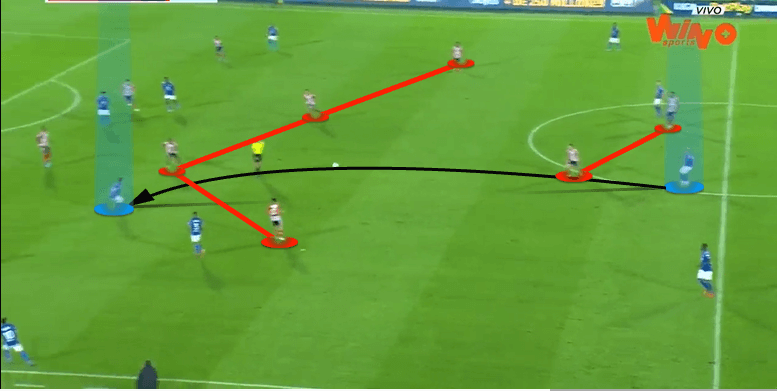
The advanced DMC moves towards the ball and into the pocket between the defence and midfield. The opposition midfield is slightly stretched due to the inverted left-back pulling the right-midfielder a few yards wider than he would otherwise have been.
This opens up just enough of a gap to allow Vásquez to play into the advanced DMC’s feet. This pass takes out six opposition players – the two forwards and their entire midfield. Although the positioning of the midfielders and left-back allows this pass to be made, it is of course the quality of Vásquez and his passing ability that make the pass possible.
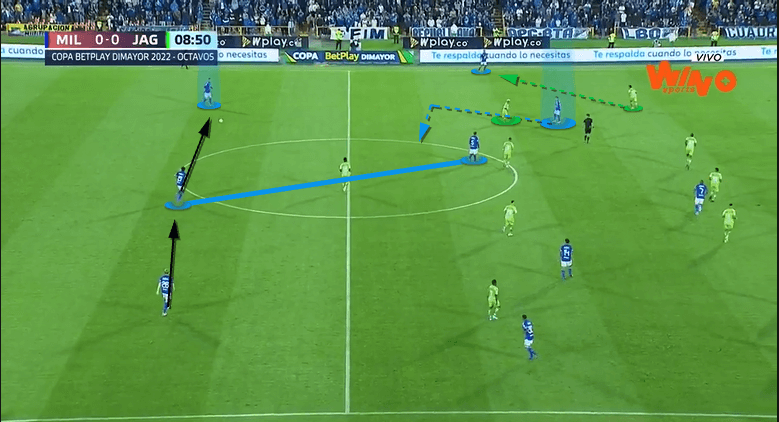
In this example, it is number ‘21’ Juan Pereira that drops deep and Vásquez that takes up the more advanced position. As his body shape indicates, Vásquez is not interested in receiving the ball in front of the opposition’s midfielders. The DMC has started drifting in behind the opposition’s midfield, who are tightly packed together and without much space between the lines either.
The left-forward is in the half-space and the left-back is high with his heels on the side-line. The centre-back shapes as though he is going to pass the ball to his left-back. This results in the opposition right-back beginning to close down the Millos left-back.
The left-forward, from the half-space, initially makes a run straight towards the ball, brushing past the widest opposition midfield player. With the midfielder now tracking him, the forward makes a sharp turn inside the pitch.
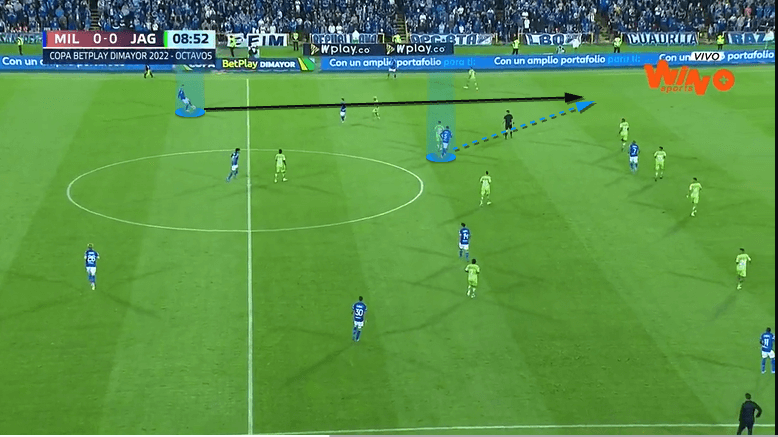
The combination of the left-forward and the left-back’s movements opens a passing lane for the centre-back to play in between the opposition’s right wing-back and right-centre back. The DMC’s relatively high starting position allows him to be a threat in behind the opposition’s defensive line.
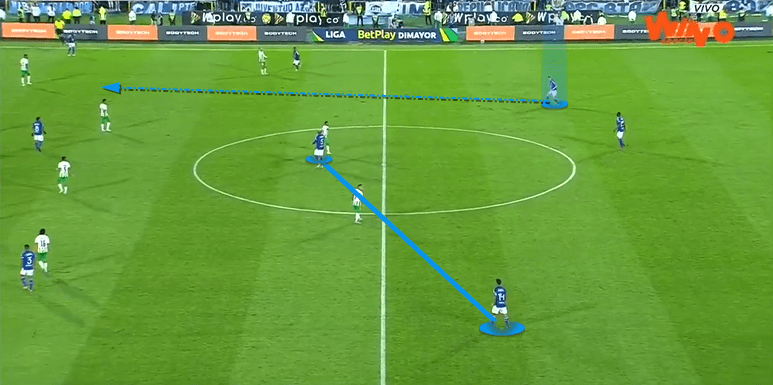
An important part of Millonarios’s build-up play is the willingness of their centre-backs to dribble out from the back. Their ability to do this allows them to break lines with the ball at their feet and disrupt the opposition’s defensive block.
In the above example, the number ‘14’ David Silva, playing as an AMC, has rotated into the DMC position. He has dropped between the CB and left-back to create a back three.
Vásquez, in the other DMC role, is staying close to the opposition forward closest to the ball. As the centre-back begins to progress forward, Vásquez shows for the ball which keeps the forward near him and out of his centre-backs path.
Millonarios’s right back occupies the opposition’s left-midfielder. He does this by making a double movement – initially moving towards the ball, engaging the left-midfielder, then making a forward run to push the midfielder back towards his own goal.
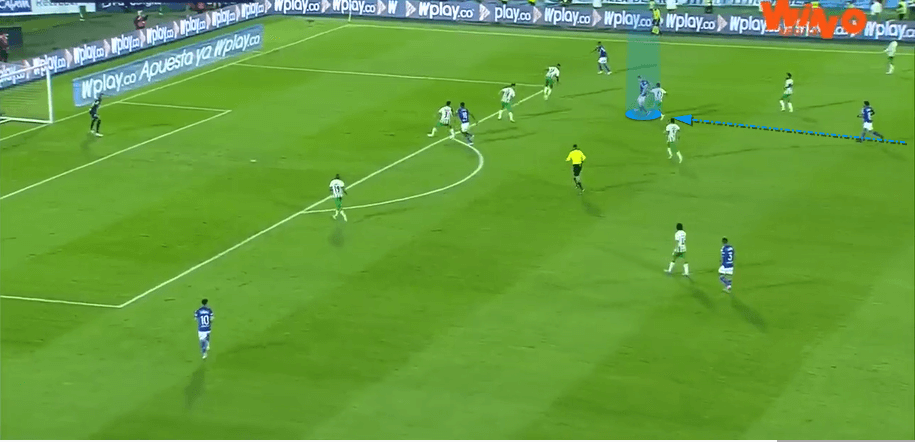
The positioning and movements of his teammates allow the centre-back to drive with the ball into the opposition’s half. He is almost at the penalty box before he is engaged by the opposition. His run bypassed six opposition players.
The players ahead of him make movements to stretch the backline and to be played in behind. His defensive midfielders fill the space behind him giving him insurance should he lose the ball.
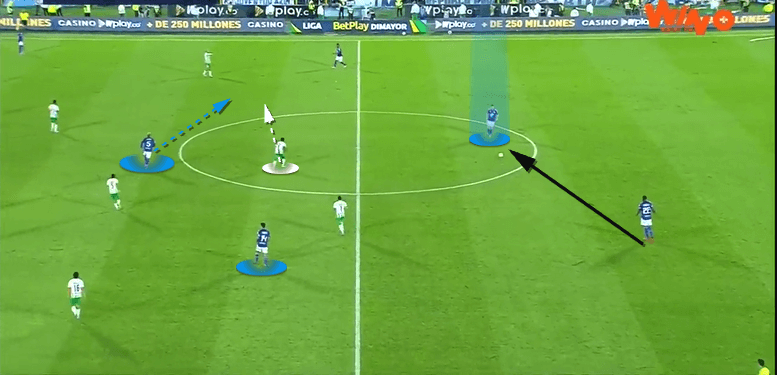
In this example, Silva has again rotated into the defensive midfield position to receive the ball from his left-centre back. The pass into the midfielder was not on, due to Silva being pressed, so the CB switched it to the opposite centre-back. Silva then held his position whilst Vásquez showed for the ball in the right half-space.
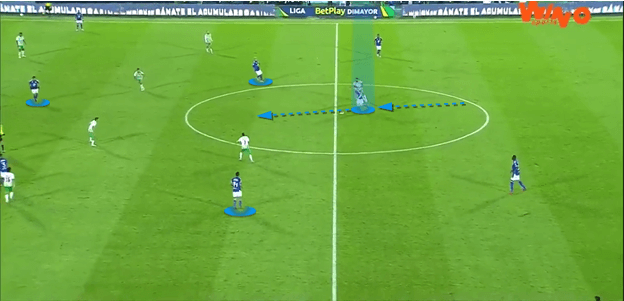
Vásquez’s action pulled the pressing forward towards him, creating a gap between the two pressing forwards. The centre-back drove through this gap with the ball at his feet. This caused the central midfielders to narrow which created space down the side of them.
Inverted full-backs
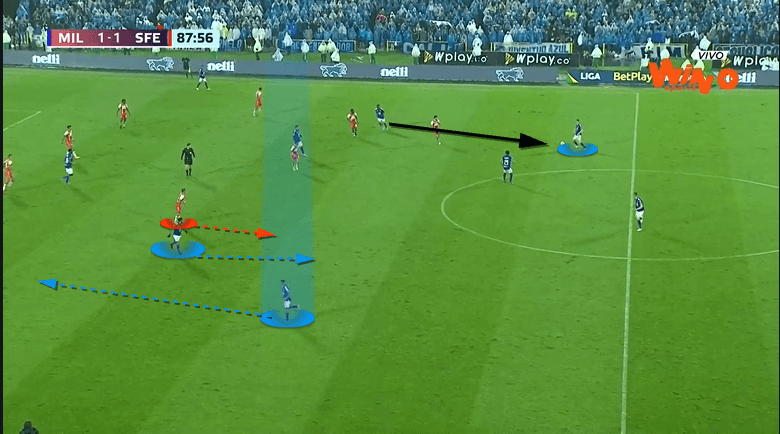
Millonarios use their full-backs in a variety of intelligent ways. Often, they move inside the pitch with their wide forwards providing the width. The above image shows the left-back, number ‘3’ Omar Bertel, in the half-space as the ball is about to be switched from right to left.
As the ball comes across the pitch Bertel, instead of widening the play, makes a straight line run towards the opposition’s right-back. The attacking midfielder drops into the space vacated by his inverted left-back.
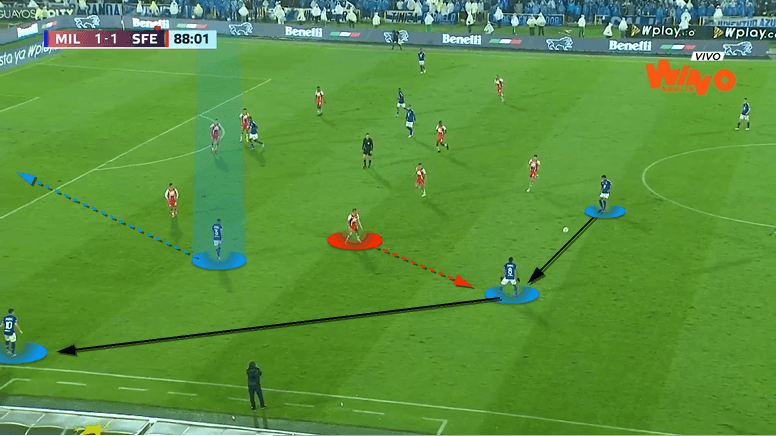
The above image shows the AMC as he is about to receive the ball. His movement has prevented the opposition’s widest midfielder (highlighted) from covering the wide area as he is forced to engage the AMC.
Bertel’s run in the half-space means the opposition right-back is also pinned. Both these movements combine to allow the left-forward to receive in space. With more than enough time to take a touch and get his head up, the left-forward provides a pinpoint cross. Bertel, who has continued his run into the box, flicks the cross on to provide an assist for Millonarios’s winning goal.
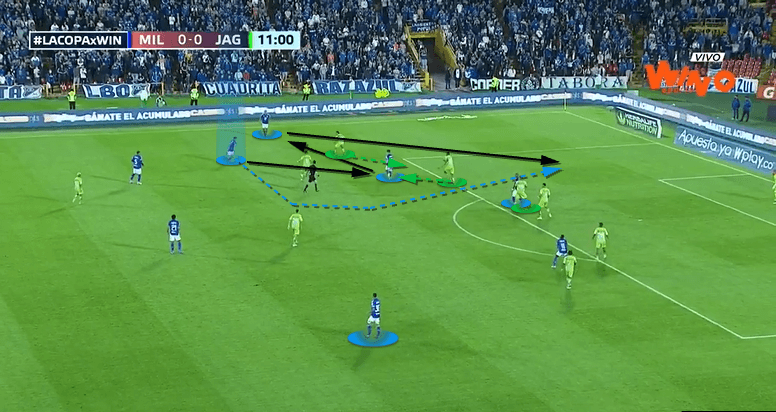
The above image shows the positioning of the full-backs during a sustained positional attack. Both are inverted and in their attacking third of the pitch. This positioning helped Millos in breaking down Jaguares’ back-5 as well as allowing the full-backs to counter-press in the final third should they lose the ball.
In this scenario, Bertel drives at the widest central midfielder. When the midfielder commits, the left-back passes to his AMC who is playing in front of the right-centre back. This pass makes the right centre-back jump to the ball. It also causes the right-winger to narrow. The AMC then bounces the ball first time out to his left-forward.
Bertel continues his run on the blindside of the central midfielder whose eyes are drawn to the ball. He then runs between the right centre-back, who has stepped out of the backline to press the AMC, and the central centre-back, who is being pinned by the centre-forward.
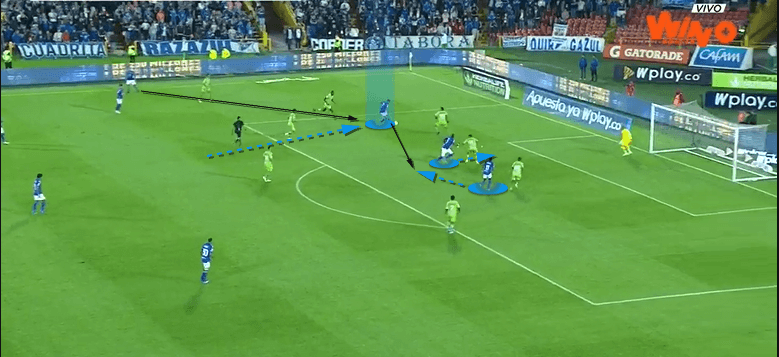
The left-forward then plays in Bertel who runs onto the ball in the assist zone of the 18-yard box. As he receives the ball, the nearest forward makes a run towards the near post. This pushes the centre-backs towards their own goal and leaves space for his right-forward to cut into. Bertel then delivers a cut-back to the second forward.
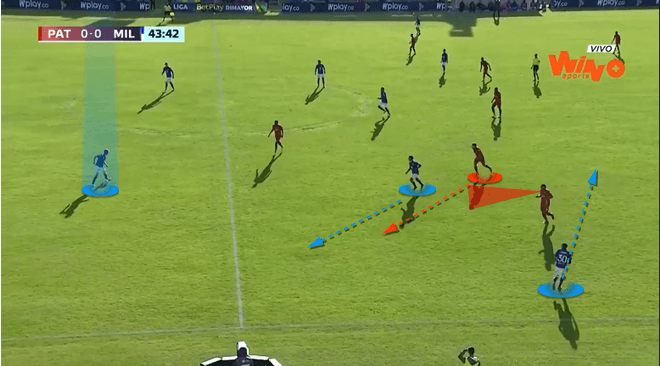
In this situation, as the centre-back has received the ball, one of the DMCs moves into the wide area, between the centre-back and the right-back, number ‘30’ Ricardo Rosales. The opposition’s central midfielder follows the DMC into the wide area to try and prevent him from getting on the ball.
With the left-midfielder focusing on the ball, Rosales sneaks behind him and into the space vacated by his DMC.
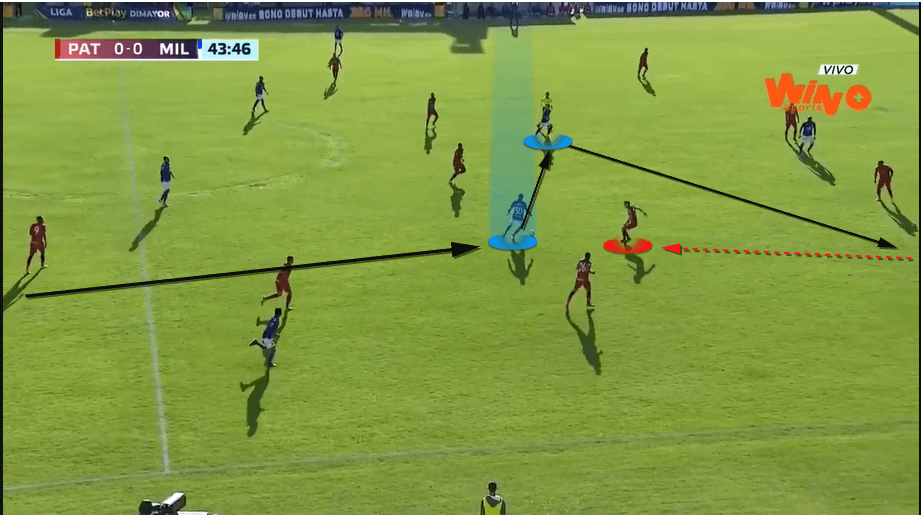
Rosales receives the ball between the lines in front of the opposition left-back, who jumps out of position to close him down. Rosales combines with Silva who can play a through ball to the unmarked right-forward.
Conclusion
Millonarios’s playing style and tactical rotations, whilst appearing free-flowing, are well-rehearsed and allow them to dominate matches.
Having gone out at the group stages of the playoffs, in large part by failing to score enough goals, Gamero may well feel he has to improve that aspect of the team. Forwards Cristian Arango, who left to join LAFC in August last year, and top scorer Fernando Uribe, who joined Junior in January, have yet to be effectively replaced.
However, Gamero’s side still finished top of the league despite underperforming their xG and expected points. They also have one of the youngest teams in the league, many of whom will be in their peak performance age for the next few seasons. This, combined with their dominant playing style, suggests there are exciting times ahead for Millos.






Comments